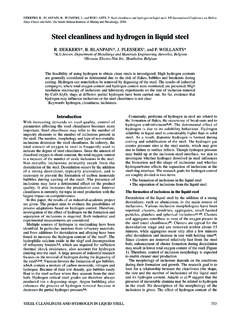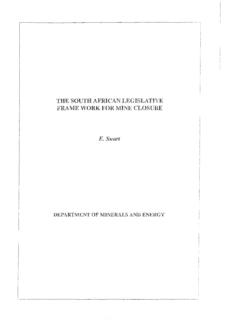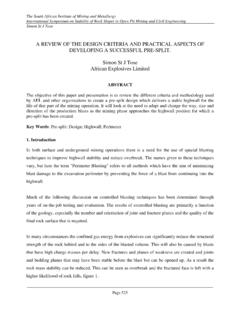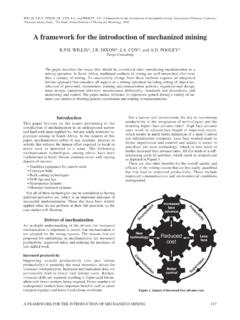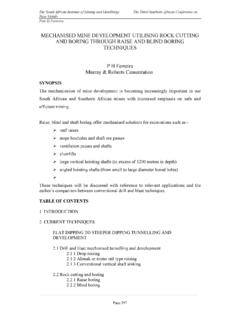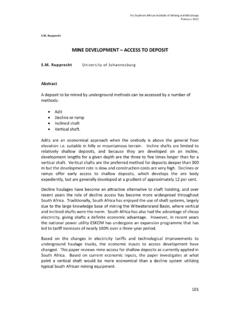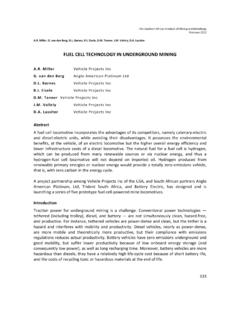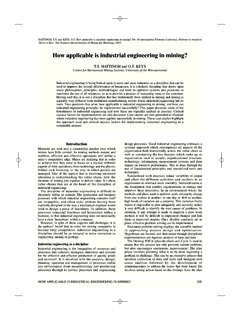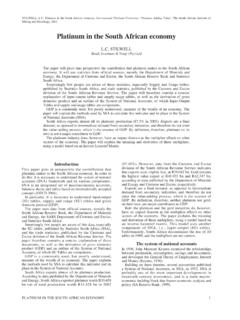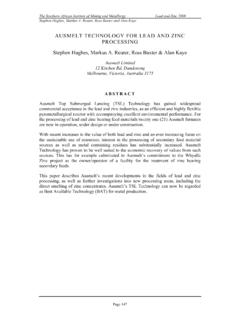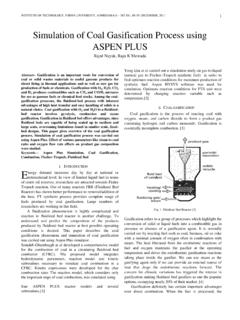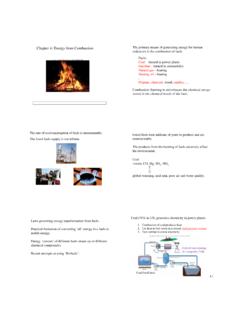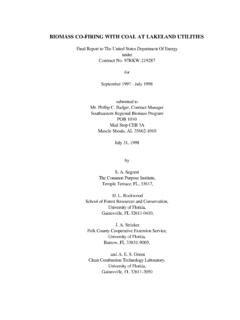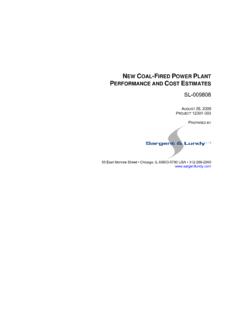Transcription of Representation of coal and coal derivatives in …
1 The Southern African Institute of Mining and Metallurgy Pyrometallurgical Modelling Theron and E. le Roux 1 Representation of coal and coal derivatives in process modelling Theron and E. le Roux Exxaro Resources Limited This paper provides guidelines on performing mass and energy balance modelling involving coal and coal derivatives . Usually, the inputs to a pyrometallurgical process would be specified in terms of elements and compounds. Reliable thermochemical data is more widely available for species involving uniquely defined, relatively smaller molecules. However, in the case of coal, the molecules are extremely large and not uniquely defined.
2 Consequently, modelling processes involving coal and its derivatives have several potential pitfalls. These are outlined in the present paper. The main findings are as follows: Coal proximate analysis should not be regarded as absolute; it could vary with several parameters, including heating rate For modelling, the use of ultimate analyses should be considered a preferable option to proximate analyses, where, fixed carbon and volatiles are not defined in terms of chemical composition Significant errors could be made if the larger molecules are neglected during calculation of the calorific value (CV) of coal gas (the gas liberated when coal is heated in the absence of oxygen) For elemental analyses, the oxygen content (which is calculated by balance)
3 Should be checked to ensure it is within the expected range For Representation of sulphur in coal, double-counting due to SO3 in the ash analysis should be avoided Potentially, oxygen in coal could be represented as O2, H2O, CO, or CO2; however, use of some of these species without considering the experimentally determined gross CV results in significant errors in the energy balance. If coal enthalpy is calculated from elemental analyses without correction, Representation of coal oxygen as H2O(l) gives reasonable accuracy (up to error for a set of South African coals). Coal volatiles could be represented by a complex mixture of compounds, even using different oxygen-containing species than the abovementioned four, provided the enthalpy is corrected It is recommended that an enthalpy correction value is incorporated in energy balances involving combustion, devolatilization, or conversion of coal and coal derivatives , coke, char, or tar.
4 That would imply that proximate analysis, elemental analysis, as well as the gross CV would be required for all solid or liquid coal-derived substances being modelled. No other correction due to the form of carbon being different than graphite should be used, as that would imply double-counting some effects. Introduction Coal is possibly the most heterogeneous substance used in the metallurgical industry, especially the sector involving processing at high temperatures. Coal derivatives include coke, char, tar, pitch, and coal gas, all of which are important commodities in industry. Coal is used extensively in the metallurgical industry for widely different purposes, electrical power generation, reductant manufacturing (coke and char), as well as gasification, which allows the value of coal to be extended to a wide range of chemical products.
5 Pulverized coal injected into the blast furnace (for the purpose of decreasing coke consumption) is subjected to significantly different conditions than pulverized coal used for power generation. Reductants such as anthracite fed to an open arc smelting process are subjected to a rapid rate of heating. Lump coal fed into the Corex (Institute for Industrial Productivity, 2012a) smelt-reduction or rotary kiln Direct Reduction (DR) Pyrometallurgical Modelling 2 processes (Institute for Industrial Productivity, 2012b) is subjected to reducing conditions as well as a relatively rapid rate of heating. It is therefore important to understand the physiochemical properties of coal in different applications in order to extract maximum value from the available coal resources.
6 process modelling plays an important role in extracting this value through a detailed understanding of the quality and physiochemical properties of the coal and its derivatives . This paper highlights some of the relevant issues and potential pitfalls present in the modelling of coal. The focus is on the application of proximate and ultimate analysis of coal, with specific reference to oxygen content and the effect of different assumptions around its Representation on the calculated calorific value (CV). Current evaluation methods for coal include proximate analysis, total sulphur, and CV. Proximate analysis includes moisture, volatiles, ash, and fixed carbon yields.
7 (Note the preference for the word yields in this context, as opposed to contents . That is because coal actually contains minerals and not ash. Ash is the remnants of minerals after complete oxidation of the coal.) Most often these analyses are not adequate to fully describe the behaviour of the coal in the specific process . Technologists, especially in the fields of power generation and coke-making, properly consider the results of a number of additional tests, elemental analyses, ash analysis, ash fusion temperature, and coal petrography. Coke-makers consider coal plasticity tests ( Gieseler fluidity and dilatation) and those involved in power generation consider coal reactivity, especially from drop tube oven results.
8 The use of mathematical modelling in metallurgical and chemical processes Mass balance modelling is simply based on the law of the conservation of mass. Although the concept is simple, there are potential pitfalls associated with these calculations, especially for coal. The same applies to energy balances, which are based on the enthalpy function. Considerable time has passed since the initial development of the study field of thermodynamics and introduction of the concept of Gibbs free energy (Bodner Group, 2014). Nowadays, exploiting the concept of Gibbs free energy minimization is easier than previously, due to the availability of useful databases, software, and computers.
9 Usually one would specify an input to a pyrometallurgical process in terms of elements and compounds. However, in the case of coal, the molecules are extremely large and not uniquely defined. Reliable thermochemical data is more widely available for species involving uniquely defined, relatively simpler molecules. Nevertheless, it is essential to understand the limitations of mathematical modelling. The quality of the output is depending on the following: Accuracy of inputs Understanding of the process Validity of assumptions Intent of the model Inherent limitations of modelling The level of skill of the person undertaking the task, including the use of checks and balances The time allowed for execution of the task, which if not enough, could result in unjustified assumptions being made.
10 Proximate analysis Moisture content Preparation of a new coal sample would include air-drying the coal. That means drying the coal at ambient temperatures or at elevated temperatures not exceeding 40 C (SANS 589:2009, 2009). The apparently dry coal obtained is referred to as air-dry . The mass loss from wet coal to air-dry coal is referred to as free moisture content. The mass loss when a sample of air-dry coal, after proper sample preparation techniques, including milling, is heated to a temperature of between 105 C and 110 C, is referred to as residual or inherent moisture. The sample is then referred to as dry or absolutely dry.
